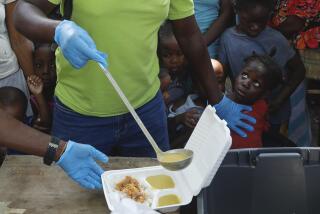Millions of Children Put at AIDS Risk : Health: WHO estimates that up to 10 million youngsters will be infected by the year 2000.
- Share via
GENEVA — AIDS has started striking many more children than previously thought, in what the World Health Organization described today as a tragic new stage in the epidemic.
Releasing figures on AIDS in children for the first time, WHO said the HIV virus that causes acquired immune deficiency syndrome will probably infect 10 million children by the year 2000.
“The vast majority of these will have developed AIDS and died by the year 2000,” said Dr. Michael Merson, director of the health organization’s global program on AIDS.
Chances are 30% that a child born to an infected woman will have the virus. The other 70% run a high risk of becoming orphans as their parents die of AIDS.
Merson said most cases of AIDS in children have occurred in the last few years, since women had to become infected first.
“This is a new phase of the epidemic,” Merson told a news conference before leaving for the world summit on children which will discuss such issues in New York Saturday and Sunday.
“Lessening this social tragedy will require the best preventive measures that we have to offer, in particular those aimed at reducing sexual transmission of HIV.”
Already one-third of the 1.2 million estimated cases of full-blown AIDS to date are believed to have occurred in children under the age of 5. A further 300,000 children have been infected but have not yet contracted the disease.
Four out of five children born with the virus develop AIDS by their fifth birthday. Once they have AIDS they usually die in one or two years.
The new data on children has forced the health organization to revise its overall projection of HIV infection by the year 2000 to between 25 million and 30 million. Previous estimates projected 15 million to 20 million cases.
Children in the developing world, especially sub-Saharan Africa, are being struck hardest because AIDS is being transmitted mainly through heterosexual activity.
In North America and Europe, infection is usually through homosexual activity and intravenous drug use.
Relatively large numbers of women in the developing world have contracted the virus--the world now has an estimated 3 million infected women of childbearing age--and they can pass it on in the womb to their children.
More to Read
Sign up for Essential California
The most important California stories and recommendations in your inbox every morning.
You may occasionally receive promotional content from the Los Angeles Times.










